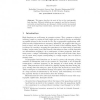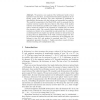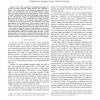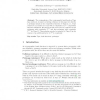AC
1998
Springer
14 years 7 months ago
1998
Springer
This paper describes the state of the art for cryptographic hash functions. Different definitions are compared, and the few theoretical results on hash functions are discussed. A...
TALG
2008
14 years 7 months ago
2008
Abstract. We present a new analysis of the well-known family of multiplicative hash functions, and improved deterministic algorithms for selecting "good" hash functions. ...
IJSN
2007
14 years 7 months ago
2007
Abstract— Fast virus scanning is becoming increasingly important in today’s Internet. While Moore’s law continues to double CPU cycle speed, virus scanning applications fail ...
CAI
2007
Springer
14 years 7 months ago
2007
Springer
Abstract. The security of iterated hash functions relies on the properties of underlying compression functions. We study highly efficient compression functions based on block ciphe...
GLOBECOM
2008
IEEE
14 years 7 months ago
2008
IEEE
Hash functions have a space complexity of O(n) and a possible time complexity of O(1). Thus, packet classifiers exploit hashing to achieve packet classification in wire speed. Esp...
CHES
2010
Springer
14 years 8 months ago
2010
Springer
The need for lightweight (that is, compact, low-power, low-energy) cryptographic hash functions has been repeatedly expressed by application designers, notably for implementing RFI...
WEWORC
2007
14 years 8 months ago
2007
The cryptanalysis of the cryptographic hash function Tiger has, until now, focussed on finding collisions. In this paper we describe a preimage attack on the compression function ...
ICISC
2007
14 years 9 months ago
2007
We analyse the security of new hash functions whose compression function is explicitly defined as a sequence of multivariate equations. First we prove non-universality of certain ...
ACISP
2010
Springer
14 years 9 months ago
2010
Springer
Hamsi is one of 14 remaining candidates in NIST's Hash Competition for the future hash standard SHA-3. Until now, little analysis has been published on its resistance to diffe...
ARITH
2005
IEEE
14 years 9 months ago
2005
IEEE
Hash functions are an important cryptographic primitive. They are used to obtain a fixed-size fingerprint, or hash value, of an arbitrary long message. We focus particularly on ...




